by Heather Kent | Jan 13, 2023
Did you know that MLK Day is the only federal holiday designated by US Congress as a national day of service? Instead of a “day off” from school or work, Americans are encouraged to spend the day serving others. Coretta Scott King said:
“The greatest birthday gift my husband could receive is if people of all racial and ethnic backgrounds celebrated the holiday by performing individual acts of kindness through service to others.” MLK Day is always the third Monday of January.
In honor of Dr. Martin Luther King, Jr.’s legacy of service, this blog post brings together several resources to support 4-H service projects to live out our motto, “make the best better.”
What is the Difference Between Service Learning and Community Service?
Service to the community is one of the pillars of 4-H membership. Our pledge includes “My HANDS to larger service.” All 4-H members and clubs are encouraged to plan and execute at least one service project each year. Community service and service learning are often confused. Community service can be court-mandated and sometimes has a negative connotation. However, the biggest difference between community service and service learning is that community service is usually a “one and done” activity where youth collect food, clothes, or other items for a local organization or pick up litter. There is nothing wrong with these types of activities, but youth usually have little input on them, and they are one-time events. This is perfect for younger youth. In contrast, service learning is a longer-term process where youth identify a community need, develop a proposal or plan to address that need, and often involve other community organizations or officials to take action. Service learning is a great way for older youth and teens to develop awareness and empathy. For more information about the differences between service learning and community service, check out our previous blog post.
Getting Youth Involved in Service to Others
Service to others is a huge part of the 4-H Model. Not only is it part of our pledge, Generosity is one of the 4-H Essential Elements, and something we strive to integrate throughout our programming. 4-H Clubs are encourages to participate in at least one community service or service learning project each year- it one of many standards for club and individual members. If you are not familiar with standards of excellence, it is part of our 4-H Awards and Recognition Program. To learn more, check out this previous blog post or be sure to attend our workshop on Awards and Recognition next weekend at our Northwest 4-H Volunteer Forum.
Finally, there is a grant program to help clubs with service learning! It’s called 4-H Community Pride, and not only does this program provide funding for service learning, there is a comprehensive leader’s guide to help volunteers, youth, and parents plan, execute, and celebrate thier service learning.
Ideas to Kick Start Community Service or Service Learning
If you are in need of some fresh ideas for service learning, be sure to read “17 Ways to Kick Start Your Service Learning.” We will also offer a workshop on Service Learning during our Northwest 4-H Volunteer Forum next weekend in Destin, FL. Finally, during our upcoming Northwest 4-H Teen Retreat, youth will have the opportunity to participate in a service project our youth planning committee selected. They will be making teddy bears to give away at a summer camp for youth with disabilities.
by Heather Kent | Jun 16, 2021
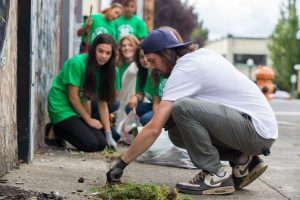
photo credit: National 4-H Council
One of the requirements for 4-H clubs to be chartered is annual participation in a service project because it helps youth develop compassion and empathy for others. This is an important step to help youth live our pledge “my heart to greater loyalty” and “my hands to greater service.” Recently, the terms community service and service learning are being used interchangeably, but they are not the same. This post will explain the difference between the two and provide additional resources for 4-H parents, volunteers and club officers.
What is community service?
Community service is usually a “one and done” activity. It is often associated with short term volunteerism, and sometimes can be associated with court-mandated sentences. Community service includes things like a food drive, clothing drive, or litter pick up. These types of activities help youth apply the “heart” and “hands” parts of our pledge, but youth typically do not organize the activities; they are often done in collaboration with another organization, such as Toys for Tots, a local food pantry, or Adopt a Highway. Community service is a great way to introduce the concepts of giving back to the community and helping others. It is very appropriate for our younger 4-H members, who don’t yet have the critical thinking, decision making, and leadership skills to execute a service-learning project.
What is service learning?
Service learning engages not only the “heart” and “hands” but also the “head.” Service learning is a process in which youth identify a need, develop solutions to address that need, implement a plan to put their solution into action, and reflect on the results of their action. Service learning should be planned and implemented by youth, with parents and volunteers supporting and guiding the process. Service learning is more appropriate for older youth who are ready to take on more responsibility. Service learning not only helps youth develop a sense of compassion, but it also helps them develop more independence.
So What’s the Difference?
For example, when a 4-H club decides to lead a food drive for the local pantry, they are contributing to the issue of food insecurity. Food drives are an effective way to meet the immediate need for more food, or more nutritious food. Our annual Peanut Butter Drive is a great way for 4-Hers to get involved with food insecurity; the Florida Peanut Producers match what is collected and everything is donated to a local food pantry. However, if youth want to address the issue of food insecurity in a more systemic way, they might choose to apply GPS technology to map the food deserts in their community or county. Next, they might present their findings to county commissioners or the chamber of commerce. Together, they brainstorm solutions on how to address food insecurity issues in those food deserts, but increasing awareness, or finding partners to provide sources of nutritious food. After implementing solutions, they look back and reflect on what they did, what worked, and what could be improved for next time.
Download this one-page document to help explain the difference between community service and service learning. This is a great resource for volunteers, parents and club officers. Next week, we will share ideas for service learning and community service related to a variety of issues, that can be a great discussion starter for your club meetings this fall!
If you have a passion for civic engagement and making a difference in your community, consider sharing your passion and skills with youth. We need volunteers to help youth understand what it means to be engaged in their community, and volunteers to empower youth to make a difference locally. We match volunteers’ skills and schedules with our program. Contact your local UF IFAS Extension Office for more information.
by Allison Leo | Dec 30, 2020
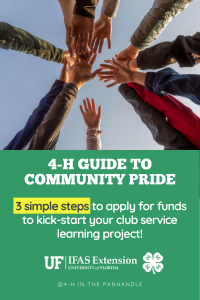 4-H clubs and individual members of all ages are eligible to participate in a Community Pride Project. This project is a great way to directly impact your community through a special service learning project of your choice. Service learning is an experiential learning activity and you can read more about what service learning is here or here.
4-H clubs and individual members of all ages are eligible to participate in a Community Pride Project. This project is a great way to directly impact your community through a special service learning project of your choice. Service learning is an experiential learning activity and you can read more about what service learning is here or here.
Community Pride is a service learning program. The objectives of the Community Pride Program are:
- Youth learn about their community and the impact the community has on their lives.
- Youth understand how to relate to their community as individuals and through group cooperation so they can effectively work in community activities, programs, and organizations.
- Youth develop skills and knowledge in community leadership.
- Youth gain experience carrying out community projects to improve their environment.
- Youth develop an interest in and love for their community.
How Does Community Pride Work?
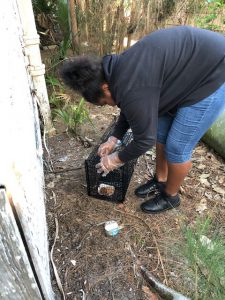
4-H member in Martin County sets up a trap for feral cats as part of the Community Pride Project Photo by: Natalie Parkell
During the project a community issue is identified, a service project is selected, a plan is implemented by the group, and reflection and reporting take place.
What types of projects can you complete through the Community Pride Grant?
That is up to you! The best thing about the project is that you get to select your service learning project based on you community’s need. There are five main steps to the Community Pride Project and those are listed in detail below. Martin County 4-H members received a Community Pride Grant to help combat feral cats in their neighborhood and you can read more about it here. Broward County 4-H members have completed a variety of projects through this program and you can see the variety of projects here. If you would like to receive a Community Pride Grant to complete a service project of your choice, follow the steps below and contact your county 4-H Agent for assistance.
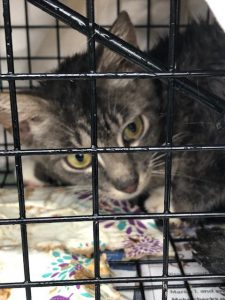
One of the cats that was captured, neutered, and released as part of Martin County 4-H’s Community Pride Project combating feral cats. Photo by: Natalie Parkell
Step 1: Community Needs Assessment
A Needs Assessment might sound intimidating and complicated, but it is a very simple step. Think of a needs assessment as a brainstorming session with the club members. They will share their input from their personal experiences in the community to figure out what project should be selected. It is important for this part to be youth-led because you want to select a project that has a community need and an interest from the youth. During the brainstorming session you will also come up with potential solutions to the problem.
Step 2: Creating a Project Plan
The next step is to create a project plan based on the ideas that were generated during the brainstorming session. Youth will select a solution that they can work towards and this solution will be the project. It is important to consider what steps will need to be completed to make the solution a reality (i.e. supply needs, work days, locating community partners, and more).
Step 3: Submit a Project Proposal
Your next step is to submit a proposal. All 4-H groups (or individual members) who would like to participate in this program must submit a proposal for funding of their Community Pride Project. Proposals accepted from the county must be emailed to 4hcontests@ifas.ufl.edu at the State 4-H Headquarters by the January 11, 2021 deadline date to be considered for the current 4-H years funding. Groups that are awarded funding will be notified via email in February with further instructions on your n
Step 4: Implement your Project
Now for the fun part! This is where you get to put your project plan into action and complete your community project. You will create your own timeline and schedule for the project and it will need to be completed between February through May 2021.
Step 5: Evaluate and Report
After your project is complete, it is time for you to reflect on all your hard work. During this time you will also evaluate the project and submit an official report to the state office by June 1, 2021. The state 4-H Office will conduct judging of all the completed projects during the first week of June. Participants in the Top Five Projects will be invited to a recognition breakfast!
2021 Community Pride Grant Important Dates:
- January 11th, 2021 – Project Proposals Due
- February 2021 – Grant Monies Disbursed
- February to May 2021 – Project Implementation
- June 1st, 2021 – Project Reports Due
Looking for COVID-19 “friendly” Service Project Ideas? Check out this earlier post for suggestions!
by Jena Gilmore | Dec 4, 2020
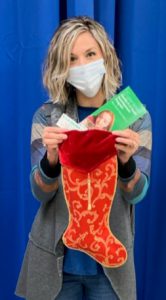
Care stockings for elderly residents.
Amid holiday season, one of the busiest times of the year, it’s a great opportunity to find ways to serve others. There are many activities that will allow you to safely relieve the fatigue of quarantine, virtual school and zoom meetings by getting into the spirit of giving through 4-H service projects.
Traditionally, community service projects would include a group of 4-H members banding together one day to clean yards for the elderly or visit nursing homes or volunteer at local shelters. Although COVID-19 limits many forms of our traditional service projects, youth and their families can still coordinate amazing opportunities amidst our new normal of social distancing. Remember, while participating in any 4-H affiliated programs or projects, all members, families, and volunteers must adhere to our safety protocols which include but are not limited to wearing masks the entire time, remaining 6-feet apart, hand sanitizing and washing regularly, and more found here.
Here are some safe alternatives to implement with your local 4-H program, club, or businesses:
- Power Hour Yardwork– If outside activities are your forte, have families sign up to clean one location together as a family unit. Remain masked, gloved, and wash hands regularly to ensure safety of yourself and others. Set obtainable goals for your one-hour timeframe to limit traffic and need for the use of facilities.
- Business Lawn Decorating- Some business, such as Elderly Rehabilitation Centers and Nursing Homes, allow outside groups to decorate the outside areas of their facilities for the holidays. This is a great way to show off your creative side and even drum up some friendly competition. Remember to follow UF COVID guidelines (wear masks, social distancing, etc).
- 4-H Care Stockings- Pack stockings with hygiene items, socks, word games, and/or prewrapped snacks and deliver them to long term care facilities or even local businesses. Be sure to include information on 4-H, whether it be a card, business card, or 4-H pledge bookmark! You never know where we may find new 4-H Volunteers or members.
- 4-H Book Buddies- Find a facility that would allow you to read a book (even better if you dressed in character) to their clientele. While this may not be feasible in person with COVID restrictions, offer to pre-record a session and either email or share the link!
- Food Drives- Set up a location (preferably at your 4-H office) for locals to donate unperishable items in containers that can be sprayed with disinfectant spray. Work with your 4-H Agent or other adults to set up where these items will be distributed to.
- 4-H Furever Gifts- Put those sewing (or tying) skills to good use and make some dog toys, blankets, or beds out of old t-shirts or jeans. These make perfect donation pieces to pet shelters and rescue facilities!
- 4–H Pen Pals- Contact your local elderly residential facilities to see if 4-H members could submit cards/letters to residents. Be sure to speak to someone in management to get approval for contact information. Another alternative to this would be to contact classroom teachers and ask if you can send a letter or card to the class. This would be a great way to recruit future 4-H’ers too as you share your own stories!
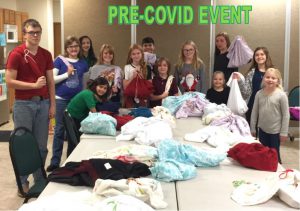
4-H’ers packed pillow case hygiene packs for residents at the Chautauqua Rehabilitation Center.
Service projects are an excellent method of targeting life skills in the “head and heart” areas of the targeting life skills model. Teaching our youth to care about others instills empathy while teaching them the spirit of giving activates community service volunteering. For more ways to volunteer in your county, check with you local 4-H office and seek ways that you can volunteer with 4-H today!
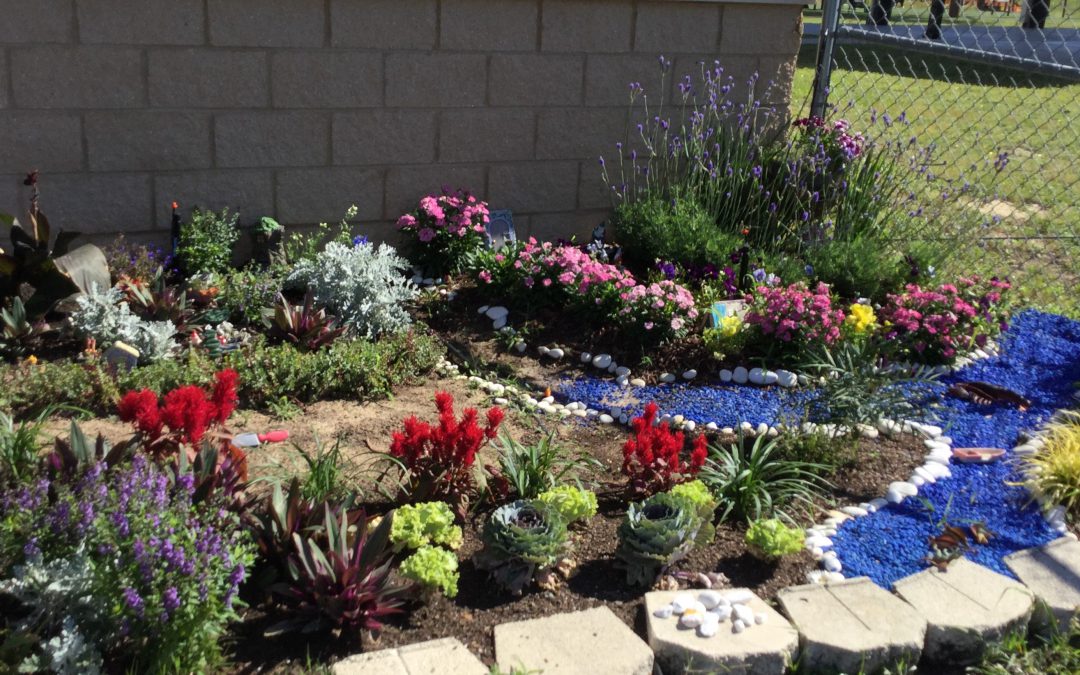
by pmdavis | Jul 5, 2019
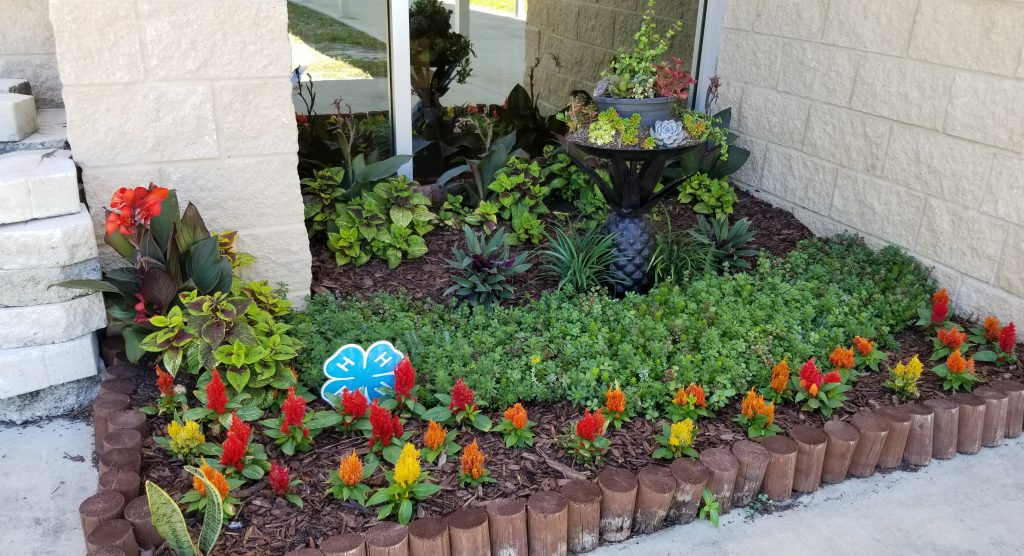
Succulent garden at entry of NSA-PC Youth Center
In September 2018, Ms. Bettina started the 4-H Garden Club at NSA-PC in Panama City, Florida. She had big plans for the garden and couldn’t wait to get started. These Navy youth, led by a caring adult staff member, started their 4-H journey. Then Hurricane Michael came, which devastated the area on October 10, 2018 and could have easily derailed all of their plans. Instead, the storm allowed youth to start with a clean slate and a renewed sense of vigor in rebuilding the garden at the NSA-PC Youth Center. The youth redesigned some of their beds using debris from the storm.
When the Youth Center reopened following the storm, most of the outdoor areas were off limits to the kids due to damage from the storm. That meant that the playground and other outdoor activities were not available. However, the 4-H Garden Club was allowed to function and allowed the youth itching to be outside and yearning for a way to cope with the devastating effects of Hurricane Michael to come together as a team and, along with Ms. Bettina, a garden to restore a sense of balance and ownership.
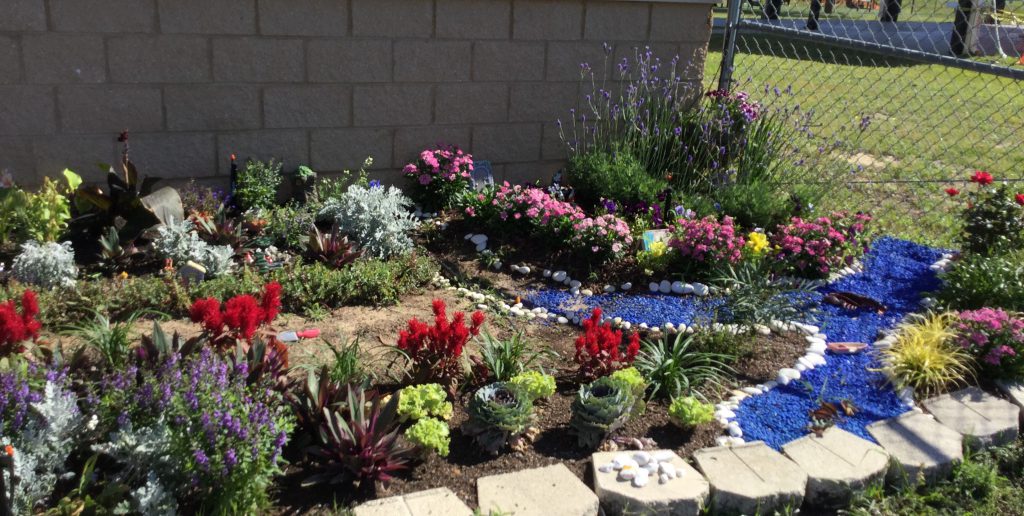
Whimsical garden bed designed by NSA-PC youth
The kids were eager to get started planning, implementing, and maintaining the new garden area. They created a plan for different types of gardens within their facility spaces. They researched which plants were best suited for the season and zone as well as which flowers would attract pollinators, because they hoped to see hummingbirds and butterflies. Ms. Bettina says that the kids came in every day asking if they were going to get to work in the garden. It created a healthy, active, and creative outlet for all involved. Soon the garden began to take shape with imaginative details and originality everywhere you looked.
All visitors to the Youth Center are welcomed by exquisitely maintained flower beds that surround the entrance to the building. The youth have created and maintained a beautiful area that enhances the building and greets visitors with beauty and color. These raised gardens are filled with hardy greenery as well as seasonal color and elevated containers that hold a cascade of many varieties of succulents.
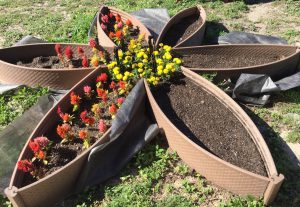
NSA-PC youth recycled old materials to create a new space to hold their flowers.
The 4-H Garden Club at NSA-PC is a perfect example of how sometimes a storm that seemingly derails plans actually presents an opportunity for growth, learning, and creating something more beautiful. Ms. Bettina’s 4-H Garden Club could not have come at a more perfect time. The gardening activities allow the youth to get outdoors while learning about different types of plants and how to care for them. Many students initially joined the Garden Club to get outside after the storm due to the playground closure. Youth participating in the 4-H Garden Club at NSA-PC have learned about more than just the science of plants; they are learning to work as a team with improved communication skills in order to continue maintaining their garden as well as environmental awareness and recycling by taking used items to make new treasures for their flower beds.
4-H is one of the nation’s most diverse organizations and includes people from all economic, racial, social, political, and geographic categories. There are no barriers to participation by any young person. Participants are given the opportunity to engage in activities that hold their personal interests while being guided by adult volunteers. If you would like to learn more about 4-H programming in your local area, or how to get involved as a 4-H volunteer, please contact your local UF IFAS County Extension Office, or visit http://florida4h.org.
RESOURCES
For more tips and ideas to help build your personal garden, visit http://edis.ifas.ufl.edu/ as there are many documents available to help build your personal gardens.
This article was written by Jennifer Sims and Paula Davis.











